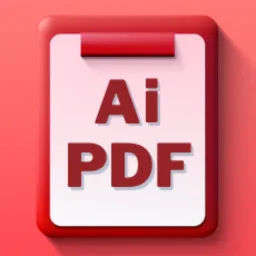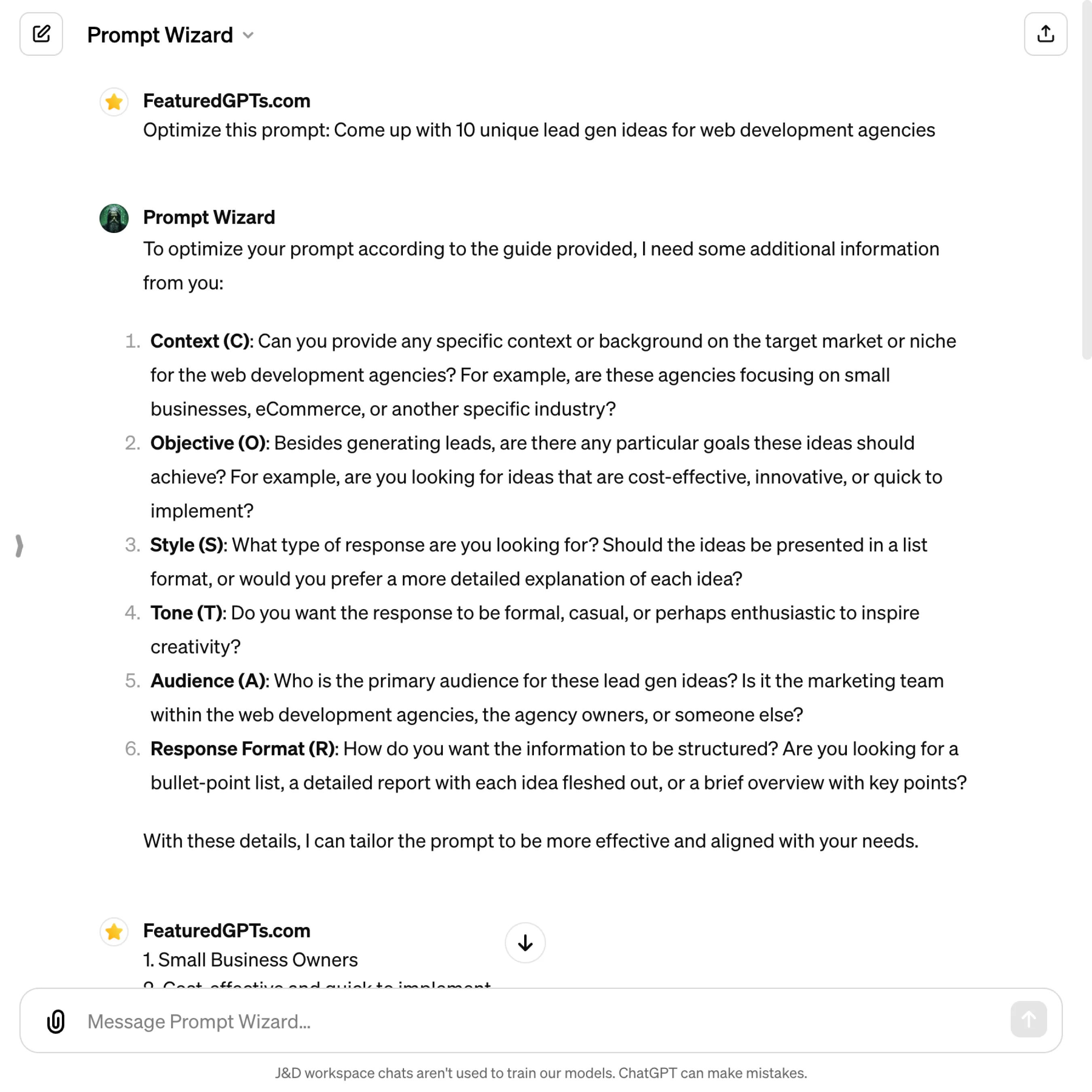
Prompt Wizard
I optimize your ChatGPT prompts to enhance clarity and effectiveness based on real LLM science.
What does Prompt Wizard do? (& its Use Cases)
Prompt Wizard optimizes your prompts to enhance clarity and effectiveness.
It employs structured frameworks and strategies to refine requests for AI processing.
For educators and students,
It simplifies complex concepts into understandable prompts.
For researchers,
It sharpens inquiries for precise, informative responses.
For professionals,
It improves communication for clearer, more impactful outcomes.
How to Use Prompt Wizard?
Optimize Your Prompts for Clarity and Effectiveness with Prompt Wizard
Prompt Wizard transforms vague or complex requests into clear, actionable prompts. This guide shows you how to harness its capabilities, ensuring you get the most precise and relevant responses from AI models.
Understanding Prompt Wizard
Prompt Wizard uses a structured approach to refine your prompts, employing strategies like the COSTAR framework and affirmative directives. It's designed to enhance communication with AI, making it more efficient and effective.
Step 1: Define Your Goal
Start with a clear understanding of what you want to achieve. Whether it's enhancing an educational prompt, clarifying a research question, or improving professional communication, your objective guides the optimization process.
Crafting Your Initial Prompt
- Be concise but comprehensive.
- Include the essential information needed to understand your request.
Step 2: Apply the COSTAR Framework
COSTAR stands for Context, Objective, Style, Tone, Audience, and Response Format. Applying this framework to your prompt ensures it covers all necessary aspects for a well-rounded request.
Context
Provide background information or the setting of your task.
Objective
Clearly state what you want to accomplish.
Style
Specify the desired style of the response, such as formal, technical, or creative.
Tone
Choose an appropriate tone, like friendly, professional, or enthusiastic.
Audience
Identify who the response is intended for, such as beginners, experts, or a general audience.
Response Format
Define how you want the information presented, like a list, narrative, or report.
Step 3: Incorporate Affirmative Directives
Use positive, action-oriented language. Directives like "do explain" or "do provide" are more effective than passive or negative constructions.
Step 4: Use Example-driven Prompting
Include examples or analogies to clarify your expectations. This helps guide the AI to produce outputs that closely match your requirements.
Step 5: Encourage a Chain-of-Thought Approach
For complex tasks, suggest breaking down the prompt into smaller, manageable steps. This encourages a deeper exploration and more detailed response.
Step 6: Assign a Role to the Model
Identify the model as an expert in a specific field if needed. This helps tailor the response to fit the desired level of expertise.
Step 7: Utilize Output Primers
Start your prompt with the beginning of the expected response. This primes the AI to continue in the desired direction.
Practical Examples
Example 1: Educational Prompt
Before: "Explain photosynthesis." After: "You are a science teacher explaining photosynthesis to a 10-year-old. Use simple language and examples to illustrate how plants use sunlight to make food."
Example 2: Research Inquiry
Before: "What's the latest on renewable energy?" After: "You are an expert in renewable energy technologies. Summarize the latest research findings for a professional audience in the energy sector. Keep the tone formal and informative."
Example 3: Professional Communication
Before: "Email to client about project update." After: "Draft an email response to a client requesting a project update. Ensure the tone is professional yet empathetic, providing a concise summary of progress and next steps."
Conclusion
Prompt Wizard is a powerful tool for enhancing the clarity and effectiveness of your prompts. By following this guide, you can structure your requests to achieve more precise and relevant responses from AI models. Start with a clear goal, apply the COSTAR framework, and utilize strategies like affirmative directives and example-driven prompting to refine your communication with AI.
Prompt Wizard's Testing Performance
Prompt Wizard's Core Features
COSTAR Framework Application
This feature structures prompts to ensure clarity and relevance. It breaks down the task into Context, Objective, Style, Tone, Audience, and Response, addressing the challenge of vague or unfocused requests.
Affirmative Directives
By focusing on 'do' instructions, this feature guides the AI to respond effectively, eliminating confusion and enhancing the precision of responses to complex prompts.
Example-driven Prompting
Incorporates examples to clarify expectations. This tackles the issue of ambiguous prompts, ensuring the AI's output aligns closely with user intentions.
Chain-of-Thought Encouragement
Prompts AI to dissect tasks into manageable steps. This methodically addresses complicated requests, facilitating deeper analysis and more comprehensive solutions.
Role Assignment
Assigns a specific role to the AI, such as 'expert reviewer'. This focuses the AI’s approach, tailoring responses to fit the desired expertise level and perspective.
Output Primers
Uses output beginnings to steer AI responses. This anticipates and shapes the structure of the AI's output, guiding it towards a desired format or conclusion.
FAQs from Prompt Wizard
Prompt Wizard's Prompt Examples
Optimizing Educational Prompts
Your task is to explain the principles of photosynthesis to a 10-year-old. You MUST use simple language and engaging examples.
You are an expert in ancient history. Write an ultra-detailed essay on the significance of the Roman Empire in shaping modern governance.
Think step by step through the process of solving a quadratic equation. Your response format should be a structured, easy-to-follow guide for high school students.
Enhancing Research Inquiry
You MUST summarize the latest findings on renewable energy technologies. Your audience is professionals in the energy sector. The tone should be formal and informative.
Your task is to compare the effectiveness of different COVID-19 vaccines. Present your findings in a structured report, addressing efficacy, side effects, and distribution challenges.
You are an expert in machine learning. Explain the impact of GPT-3 on natural language processing, focusing on advancements and limitations. The style should be technical yet accessible.
Improving Professional Communication
Your task is to draft an email response to a client requesting a project update. You MUST maintain a professional yet empathetic tone, ensuring clarity and conciseness.
You are tasked with creating a project proposal for a new marketing campaign. The response format should be a detailed plan, including objectives, strategies, and expected outcomes.
Think step by step to outline the process of conducting market research for a new product. The style should be instructive, aimed at guiding a team with diverse expertise.








